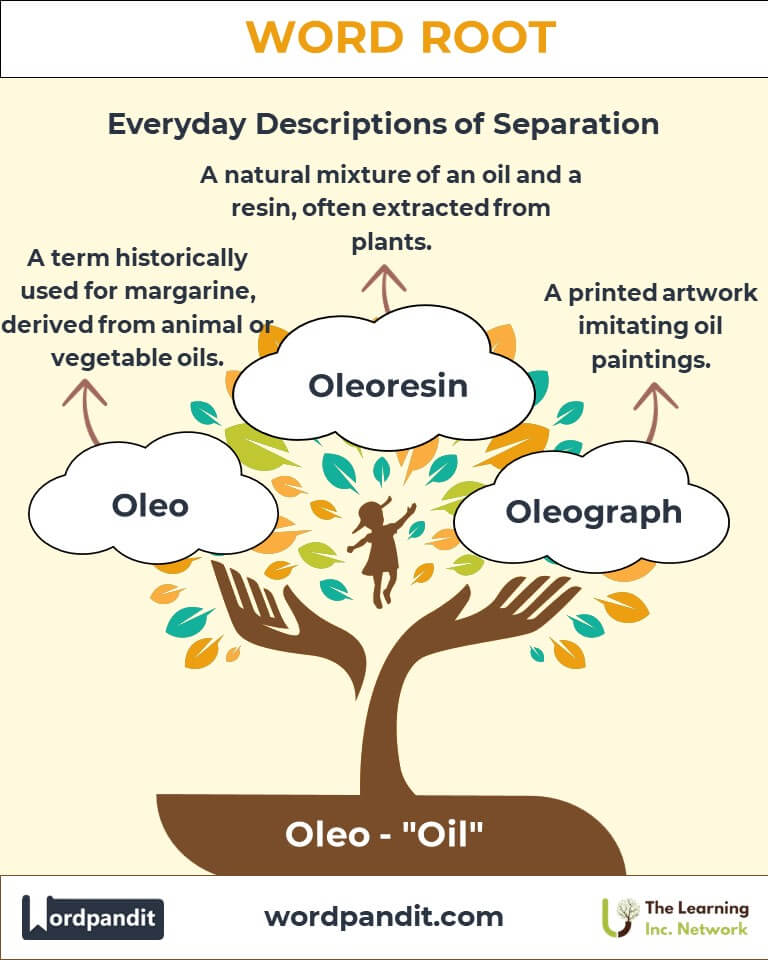Oleo: The Root of Oil's Essence in Language and Science
Discover the fascinating journey of the root "oleo", meaning "oil," derived from Latin. From oleic acids in chemistry to oleaginous descriptions in literature, this root encapsulates the significance of oil across diverse fields.

Table of Contents
- Introduction: The Essence of Oleo
- Etymology and Historical Journey
- Mnemonic: Unlocking the Power of Oleo
- Common Oleo-Related Terms
- Oleo Through Time
- Oleo in Specialized Fields
- Illustrative Story: Oleo in Action
- Cultural Significance of Oleo
- The Oleo Family Tree
- FAQs about the Oleo Word Root
- Test Your Knowledge: Oleo Word Root Quiz
- Conclusion: The Living Legacy of Oleo
Introduction: The Essence of Oleo
Imagine the golden glow of olive oil drizzling onto a fresh salad or the rich aroma of essential oils wafting through the air. The root "oleo" (pronounced "oh-lee-oh") embodies the vital essence of oil, derived from the Latin word oleum, meaning "oil." This versatile root is present in science, cuisine, and literature, symbolizing fluidity, richness, and sustenance.

Etymology and Historical Journey
The root "oleo" originates from the Latin word oleum, directly translating to "oil." Ancient civilizations, including the Greeks and Romans, used oleum for cooking, medicine, and rituals. The spread of Latin through European languages carried "oleo" into modern vocabularies, where it became central to terms in chemistry, biology, and the arts.
Mnemonic: Unlocking the Power of Oleo
Visualize an ancient Roman amphora spilling golden oil, illuminating the word "oleo." Its glow symbolizes vitality and sustenance.
Mnemonic Device: "Oleo oils the wheels of language and science, enriching every field it touches."
Common Oleo-Related Terms
-
Oleic (oh-lee-ik):
- Definition: Related to or derived from oil, particularly fatty acids.
- Example: "Oleic acid is a major component of olive oil, promoting heart health."
-
Oleaginous (oh-lee-aj-uh-nuhs):
- Definition: Resembling or containing oil; excessively flattering or ingratiating.
- Example: "His oleaginous speech dripped with insincere praise."
-
Oleoresin (oh-lee-oh-rez-in):
- Definition: A natural mixture of an oil and a resin, often extracted from plants.
- Example: "Turpentine is a well-known oleoresin used in industrial applications."
-
Oleum (oh-lee-um):
- Definition: A concentrated solution of sulfuric acid, used in chemical manufacturing.
- Example: "Oleum plays a critical role in producing fertilizers and explosives."
-
Oleograph (oh-lee-oh-graf):
- Definition: A printed artwork imitating oil paintings.
- Example: "The oleograph adorned the study, adding a touch of vintage charm."
Oleo Through Time
- Ancient Usage: The Romans prized olive oil not only for cooking but also for anointing and lighting lamps. The term oleum symbolized wealth and utility.
- Modern Chemistry: The introduction of oleic acid into scientific vocabulary marked a turning point in understanding fats and oils in biochemistry.
Oleo in Specialized Fields
- Medicine: Oleic acid is celebrated for its health benefits, including reducing bad cholesterol.
- Chemistry: Oleoresins are vital in creating varnishes and industrial adhesives.
- Art and Literature: Oleographs became a popular form of affordable art in the 19th century, bringing "oil painting" aesthetics to the masses.
Illustrative Story: Oleo in Action
In a small Italian village, young Maria discovered an ancient family recipe for herbal remedies. It involved infusing olive oil (rich in oleic acid) with local herbs to create soothing balms. Maria’s concoctions, based on oleo traditions, healed the community and eventually inspired a line of organic skincare products, showcasing the enduring legacy of "oleo."
Cultural Significance of Oleo
The root "oleo" resonates through cultures as a symbol of nourishment and vitality. Olive oil, hailed as "liquid gold" by Homer, represents health and prosperity in Mediterranean traditions. The use of oils in religious rituals and perfumes underscores the root’s spiritual and sensory importance.

The Oleo Family Tree
- Oleo- (Oil): Oleoresin, oleograph
- Lipid (Fat): Lipolysis (fat breakdown)
- Grease: Greasy, lubricate
FAQs About " Oleo "
Q: What does "oleo" mean?
A: "Oleo" comes from the Latin word oleum, meaning "oil." It refers to substances derived from or resembling oil. This root is central to terms in science, art, and culture, symbolizing richness, smoothness, or lubrication.
Q: What is oleic acid, and why is it important?
A: Oleic acid is a monounsaturated fatty acid found in olive oil, nuts, and seeds. It is celebrated for its health benefits, including reducing bad cholesterol (LDL) and raising good cholesterol (HDL). It also plays a role in skincare, being a common ingredient in moisturizers due to its hydrating properties.
Q: What does "oleaginous" mean in literature?
A: In literary contexts, "oleaginous" can describe someone excessively flattering or ingratiating, often with a slick or insincere demeanor. The term draws from its original meaning—resembling or containing oil—to metaphorically describe a person’s slippery or overly smooth behavior.
Q: What is oleum in chemistry?
A: In chemistry, oleum refers to fuming sulfuric acid, a concentrated solution used in industrial applications like fertilizer production, petroleum refining, and chemical synthesis. Its high reactivity makes it indispensable but also hazardous.
Q: How are oleoresins used?
A: Oleoresins are natural plant extracts combining oil and resin. They are used in various fields: as flavor enhancers in food (e.g., paprika oleoresin), as bases for perfumes in cosmetics, and as ingredients in industrial varnishes and adhesives.
Q: What is the significance of olive oil in the context of "oleo"?
A: Olive oil, a prime example of "oleo," has been valued since ancient times for its culinary, medicinal, and ritualistic uses. It symbolizes health, prosperity, and spirituality in many cultures, reflecting the richness inherent in the "oleo" root.
Q: What is an oleograph?
A: An oleograph is a printed image designed to imitate the appearance of an oil painting. Popular in the 19th and early 20th centuries, oleographs made artistic reproductions affordable, bringing the aesthetics of oil paintings to middle-class households.
Q: How is "oleo" used metaphorically in language?
A: Metaphorically, "oleo" can imply smoothness, richness, or fluidity. For example, "His words flowed like oil" suggests a fluid and persuasive manner of speaking.
Test Your Knowledge: " Oleo " Mastery Quiz
1. What does the root "oleo" signify?
2. Which term describes an oily appearance or texture?
3. What is an oleograph?
4. What is oleic acid commonly found in?
5. What does "oleum" refer to in chemistry?
Conclusion: The Living Legacy of Oleo
The root "oleo" weaves through science, culture, and daily life, symbolizing sustenance and richness. From oleic acids to oleographs, its applications span the practical and artistic realms, reflecting its timeless relevance. Embrace the richness of "oleo" and let it illuminate your understanding of oil's vital role in our world.












